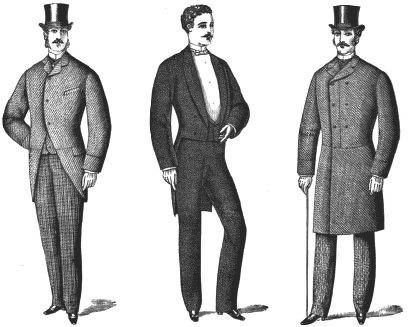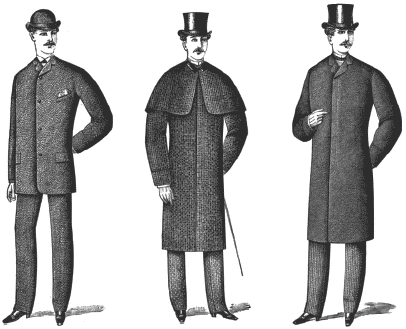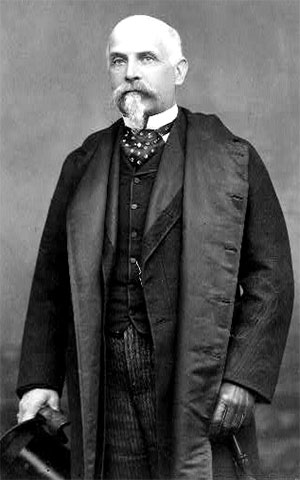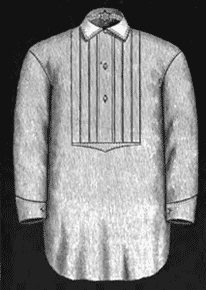How to Dress Victorian Man
Victorian Men's Clothing in the 1880s
 |
||
To the left is a Morning Coat made to button high. Well-dressed gentlemen wore dark clothing cut and made to measure. Watch-chain, one ring, shirt-stud and sleeve-buttons were all the jewelry allowable for the gentleman. |
||
The right figure features a Frock Coat of medium length in both waist and skirt, which is also made very plain and with little drapery. The shoulders are broad and the collar seam goes well up on the neck. Black and colored diagonals were in favor, edges bound narrow. |
||
|
|
||
 |
||
Lounge coats (left figure) are made about 30 inches for the average person, and fit close to the figure. Collars are low and narrow. The front is buttoned high with four or five buttonholes. The style of Overcoat shown on the center figure was fashionable during the winter. It is cut in the Chesterfield shape with a short shoulder cape worn over it. The cape is made to be detached, or fastened on the neck. The right figure features a style of Chesterfields or Ulsters, cut in a medium length and to fit the figure moderately close. Coats of this class are cut full about the shoulders. |
||
 |
||
Styles of late Victorian overcoats are featured in this plate from 1882. The styles represented are known by different names, such as the Albert, Coaching, and Newmarket and were popular for many years, the principal changes in their shapes being in the length of waist. |
||
 |
||
| T. Jefferson Coolidge in overcoat and silk hat. [Library of Congress] | ||
 |
||
| Left: Broadway Silk Hat. Right: Broadway Silk Hat w/ Mourning Band |
||
|
||
| Gentlemen's Derby Style Hats | ||
 |
||
The Chesterfield overcoats above are cut full in the shoulders and fall free and graceful round the figure. |
||
|
||
 |
||
Well-tailored shirts were offered by shirt makers both ready-to-wear and custom-made. For colored shirts the collar was of the same material as the shirt; it was common to order two false collars for each colored shirt. Flannel shirts, to show, were only for country wear, with collar-bands of grey holland. At the time of making, a spare set of wristbands for each shirt was cut, sewn, and put aside, ready to replace the originals when too tight to button. A loose shirt, somewhat on the principle of the Norfolk shirt, was adopted by sportsman. |
||
|
|
||
 |
||
| Various Styles and Sizes of Men's Shirt Collars | ||
 |
||
| Carte de Visite illustrates Victorian shirt collar and silk neckwear. [Library of Congress] | ||
 |
||
 |
||
Above are styles of silk neckwear for men. Several varieties (English square, silk puff, silk imperial) were popular and featured abundant designs and patterns. |
||
Victorian Suspenders |
||
 |
||
|
||
 |
||
Fancy hosiery styles for Victorian gentlemen feature ribbed tops with designs in stripes, plaids and diamond patterns. |
||
 |
||
For smoking or lounging attire, jackets are often lined with silk or satin quilted with cuffs and a shawl collar faced with the same material, and cut in the Chesterfield shape. When silk is n+ot used for the lining and facings, fine Angola or colored flannel is substituted. Most often, the edges and the waist girdle is of the same color as the lining. |
||

 The center Victorian man's costume is made to turn low down and narrow, and to be as straight as possible on the crease edge. The lapels are faced with silk or satin and the body and skirts are lined throughout with silk. Vests are made to open very low, to show as much linen as possible at the bottom of the roll. The front is made plain, or without a collar, with the front edges corded or finished with narrow braid laid on. Dress trousers are made of medium width.
The center Victorian man's costume is made to turn low down and narrow, and to be as straight as possible on the crease edge. The lapels are faced with silk or satin and the body and skirts are lined throughout with silk. Vests are made to open very low, to show as much linen as possible at the bottom of the roll. The front is made plain, or without a collar, with the front edges corded or finished with narrow braid laid on. Dress trousers are made of medium width.




